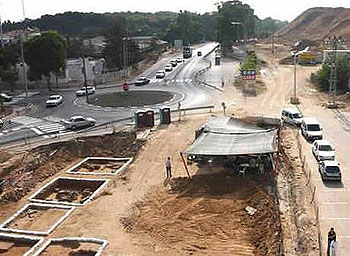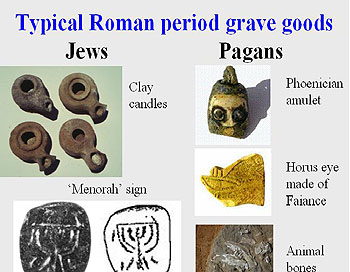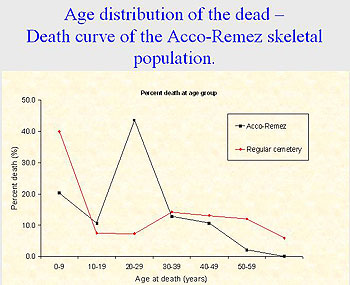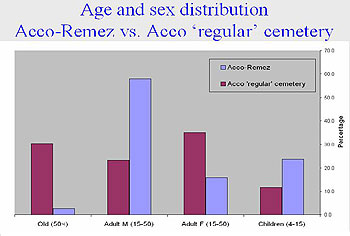The Roman military cemetery in Acre (Ptolemais), Israel
Yotam Tepper and Yossi Nagar, Israel Antiquities Authority
Acre (or Acco) is a very old town situated in northern Israel, along the shore of the western Galilee. The biblical Acco was a famous harbour city on the Phoenician coast, and a main city in the plain of Acco. Established as a police by Ptolemy II Philadelphus, it became an important Hellenistic fortification named Acco-Ptolemains. In the Early Roman Period it was made a Colony by Claudius (52-54), named Colonia Claudia Felix Ptolemais Garmanica Stabilis. Acco-Ptolemais served as an entrance point to the land of Israel during the Roman period and it was only natural that the Roman army would station there.

Figure 1. General view of the excavation.
In 2003, while constructing a road, human skeletal remains were found west of the ancient Tell. The remains included fragmentary skull and postcranial bones and some zoological remains. A big-scale excavation was launched (named Acco-Remez), directed by a staff of archaeologists led by Yotam Tepper from the Israel Antiquities Authority (Figure 1).
The excavators have discovered a cemetery, in which most of the graves were stone lined cyst graves. Taking into account Acco's long history, the dead could represent any population ever lived in Acco.
However, we the excavators have some clues: The adjoining artifacts were mostly dated to the Roman period; the big majority of the dead were anatomically articulated, indicating primary burials; and the burial direction was not consistent. But Jewish extremist orthodox demonstrators against uncovering the bones made the excavators focus mainly on the question of the ethnicity of the dead. A step by step research of the cemetery began. The preliminary results, brought about here, suggest an answer to the question "who were these people".
Dating. The pottery and glass artifacts associated with the burials confined the use of this cemetery from the middle of the 1st to the beginning of the 4th centuries (CE).
This is the Roman period in which, as we have stated earlier, the Roman army stationed in Acco where it had its colony Claudia Felix Ptolemais Garmanica Stabilis.
Theological aspects and grave goods. The Jewish law, the 'Halacha', stretched a borderline of the Holy Land, leaving Acco outside. This prevented the Jews from burying their dead in Acco during the Roman period, for just across few miles was the sacred land – a much better place to be buried at. Getzov and Stern (2002)2 have found marked difference in grave offerings between Jewish versus Pagan graves in the western Galilee. Figure 2 shows typical 'Jewish' offerings from the Roman period, versus the goods abundantly found in Acco-Remez cemetery, among them figurines and zoological remains of cattle and pigs. These goods are typically Pagan.

Figure 2. Typical Jewish vs. Pagan grave goods.
Comparison with other pagan cemeteries. Three features distinguished Acco cemetery from other regular pagan Roman period cemeteries in Israel.

Figure 3. Latin inscription.
1. Use of Latin inscription (Figure 3). Carved in tombstone, the inscription marks a name: "Olpius Martinus", and few letters telling his rake and role in the army. Eck and Tepper (2005)3 claimed that it strictly introduces the burial of a foreign Roman soldier, in the specific grave.
2. Interment of Tetradrachmas alongside the bodies (Figure 4). A hoard was found associated a skeleton of an adult male. It contained 37 Tetradrachmas used to pay Roman soldiers. It valued about 111 Dinars, the worth of few month's salary.

Figure 4. A hoard of Tetradrachmas.
3. Cremated bones. Urns with cremated bones were found in two graves. The bones were of adults, 20< years old (sex unknown). The use of cremation is very rare in Israel, even among the non-Jewish Pagan population. However, cremated bones are found in Israel in burial sites associated with Roman military presence.
Unusual burial practices. Another distinguishing feature was the unusual burial posture of the dead. Unlike the regular use of burial caves in this region, the Acco-Remez cemetery consisted of cyst graves in 'crossing' orientations: either north/south or east/west, sometimes with more than one individual in a grave.
In one case, a communal burial of 16 individuals was discovered in a big chamber, in which the dead were put either in north/south or east/west orientations, one on top of the other, as in a crossword. All the individuals in this large grave were adult males! This is unusual, and leads us to a more comprehensive paleodemographic analysis of the bones.
The skeletal remains. Most bones were fragmentary and poorly preserved. The estimation of age in most cases was based upon tooth attrition stages, the dead were sorted into 10-year-wide age groups. However, the poor state of preservation allowed in many cases only a rough estimation of age, for example: 15<, <10, based upon bone proportions and closure of epiphyses.
The estimation of sex was possible in about third of the adults. This is not much, but could be considered as an arbitrary sample representing the total age and sex distribution of the skeletal population.
The preliminary results are presented in Table 1. Based upon the archaeological evidence considering this cemetery as a "military" one, the number of females, infants, and children, in the general sample was larger than expected.
If we take into account that the cemetery was also used by the native population living at the Roman Colony, and the fact that within time some soldiers retired, got married and settled in Acco, the presence of women and children could easily be explained to some extent.

Yet, one would expect a considerable excess of adult males, something not clear enough from these preliminary results. However, a somewhat different demographic picture is accepted when putting aside individuals representing a later phase of the cemetery (eg. infants which were buried on top of a lid-covered grave, or the skeleton of individuals secondarily using cyst graves, while pushing aside the bones of the former skeletons in this grave) and leaving only loci representing the homogeneous phase of the cemetery. The death curve of Acco-Remez (Figure 5. black line) based upon this smaller sample, was compared to a typical death curve of a regular Roman-Byzantine period cemetery (Figure 5 red line). The results show marked difference between these two skeletal populations.

Figure 5. Death curve of the Acco-Remez skeletal population.
In the control population the risk of death is higher during infancy and late adulthood, as was the norm in ancient populations). However, in the Acco-Remez sample the curve is markedly different, showing an unusual peak of young adults.
Yet, a further paleodemographic comparison was made, now with another Roman period cemetery from Acco, excavated during the early 60's (Haas and Nathan 1966)4, allegedly representing a civilian population from this town.
The sex of the adults, as estimated by Haas and Nathan, is presented in Figure 3 as red bars. It is clearly shown that the frequency of adult males in Acco-Remez (Figure 6, blue bars) is by far larger than that of the regular Acco cemetery (Figure 6, purple).

Figure 6. Age and sex distribution in Acco-Remez vs. other 'regular' Roman period cemetery in Acco.
Conclusions. The dating of the cemetery to the Roman period; The burial posture of the dead and the use of cremation; The grave goods, and the paleodemographic analysis, all indicate the mainly military nature of the Acco-Remez cemetery, as preliminary postulated.
Many of the women and children in this graveyard were found in a later phase of the cemetery. Those found along with the adult males, perhaps represent the families of the soldiers, or local people associated with the Roman Colony there.
Bibliography
1. Getzov, N. and Stern, E. (2002). Between two worlds. Et-Mol 164:21-23.
2. Eck, W. and Tepper, Y. 2005. Ein Soldat der Legio VII Claudia in einer Grabinschrift aus Acco/Ptolemais. SCI, XXIV: 119-123.
3. Haas, N. and Nathan, H. (1966). Rapport preliminaire sur les squelettes trouves dans un cimetiere antique d'Acre. Memorie dell istituto Lombardo Academia di Scienze e Lettere 29:567-595.